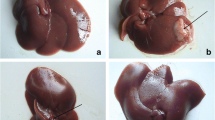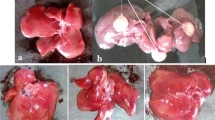Abstract
The present investigation was carried out to evaluate the antioxidant nature of ethanolic extract of Terminalia arjuna bark (EETA) on N-nitrosodiethylamine (DEN) induced liver cancer in male Wistar albino rats. Liver cancer was induced by single intraperitonial injection of DEN (200 mg/kg). After 2 weeks of DEN administration, Phenobarbital (PB) was given to promote the cancer for up to 14 successive weeks. EETA extract (400 mg/kg) was given post-orally for 28 days to hepatocellular carcinoma-bearing rats. After the experimental period, all the animals were sacrificed and serum, liver and kidney samples were collected for further biochemical analysis. The levels of lipid peroxides (LPO) under basal and also in the presence of inducers (H2O2, ascorbate and FeSO4) were estimated in serum, liver and kidney of control and experimental animals. Enzymic antioxidants, such as superoxide dismutase (SOD), catalase (CAT), glutathione peroxidase (GPx) and non-enzymic antioxidants like Vitamin C (Vit-C) and Vitamin E (Vit-E) levels were determined in all the groups of animals. A significant increase in LPO levels were observed while the levels of enzymic and non-enzymic antioxidants were decreased, when subjected to DEN induction. These altered enzyme levels were ameliorated significantly by administration of EETA at the concentration of 400 mg/kg in drug-treated animals. This protective effect of EETA was associated with inhibition of LPO induced by DEN and to maintain the antioxidant enzyme levels. Our results show an antioxidant activity of T. arjuna bark against DEN-induced liver cancer.
Similar content being viewed by others
References
Parkin DM, Pisani P, Ferlay J: Estimates of the worldwide incidence of twenty-five major cancers in 1990. Int J Cancer 80: 827–841, 1999
Bannasch P, Mayer D, Hacker HJ: Hepatocellular glycogenesis and hepatocarcinogenesis. Biochim Biophys Acta 605: 217–245, 1980
Goldworthy TL, Pitot HC: An approach to the development of a short-term whole animal bioassay to distinguish initiating agents (incomplete carcinogens), promoting agents, complete carcinogens, and noncarcinogens in rat liver. J Toxicol Environ Health 16: 389–402, 1985
Thirunavukkarasu C, Sakthisekaran D: Effect of selenium on N-nitrosodiethylamine-induced multistage hepatocarcinogenesis with reference to lipid peroxidation and enzymic antioxidants. Cell Biochem Funct 9: 27–35, 2001
Dyroff MC, Richardson FC, Popp JA: Correlation of O4-ethyldeoxythymidine accumulation, hepatic initiation and hepatocellular carcinoma induction in rats continuously administrated diethylnitrosamine. Carcinogenesis 7: 241–246, 1986
Nakae D, Kobayashi Y, Akai H, Andoh N, Satoh H, Ohashi K, Tsutsumi M, Konishi Y: Involvement of 8-hydroxyguanine formation in the initiation of rat liver carcinogenesis by low dose levels of N-nitrosodiethylamine. Cancer Res 57: 1281–1287, 1997
Beckman JS, Beckman TW, Chen J, Marshall PA, Freeman BA: Apparent hydroxyl radical production by peroxynitrite: implications for endothelial injury from nitric oxide and superoxide. Proc Natl Acad Sci USA 87: 1620–1622, 1990
Dean RT, Fu S, Stocker R, Davies MJ: Biochemistry and pathology of radical-mediated protein oxidation. Biochem J 324: 1–18, 1997
Pattanayak D, Chatterjee SR: Inactivation of sunflower NADH:Nitrate reductase by White Light-Activated Rose Bengal. Mol Cell Biol Commun 138: 237–240, 1999
Pasquini R, Scassellati-Sforzolini G, Villarini M, Moretti M, Marcarelli M, Fatigoni C, Kaur S, Kumar S, Grover IS: In vitro protective effects of Terminalia arjuna bark extract against the 4-nitroquinoline-N-oxide genotoxicity. J Environ Pathol Toxicol Oncol 21: 33–44, 2002
Jain V, Poonia A, Agarwal RP, Panwar RB, Kochar DK, Misra SN: Effect of Terminalia arjuna in patients of angina pectoris. Indian Med Gaz 36: 56–59, 1992
Hartwell JL: Plants Used Against Cancer. Quarterman Publication, Lawrence, MA, 1982
Sivalokanathan S, Ilayaraja M, Balasubramanian MP: Anticancer potency of Terminalia arjuna bark on N-nitrosodiethylamine-induced hepatocellular carcinoma in rats. Nat Prod Sci 10: 190–195, 2004
Lowry OH, Rosenbrough NJ, Farr AL, Randall RJ: Protein measurement with the Folin-phenol reagent. J Biol Chem 193: 265–275, 1951
Hogberg J, Larson RE, Kristoferson A, Orrenius S: NADPH-dependent reductase solubilised from microsomes by peroxidation and its activity. Biochem Biophys Res Commun 56: 836–842, 1974
Devasagayam TPA, Tarachand U: Decreased lipid peroxidation in the rat kidney during gestation. Biochem Biophys Res Commun 145: 134–138, 1987
Marklund S, Marklund G: Involvement of the superoxide anion radical in the autoxidation of pyrogallol and a convenient assay for superoxide dismutase. Eur J Biochem 47: 469–474, 1974
Sinha AK: Colorimetric assay of catalase. Anal Biochem 47: 389–394, 1972
Rotruck JT, Pope AL, Ganther HE, Swanson AB, Hafeman DG, Hoekstra WG: Selenium: biochemical role as a component of glutathione peroxidase. Science 179: 588–590, 1973
Omaye ST, Turabull JD, Sauberlich HE: Selected methods for the determination of ascorbic acid in animal cells, tissues and fluids. Methods Enzymol 62: 3–11, 1979
Desai ID: Vitamin E analysis methods for animal tissues. Methods Enzymol 105: 138–144, 1984
Summerfield FW, Tappel AL: Determination of fluorescence quenching of the environment of DNA cross-links made by malondialdehyde. Biochim Biophys Acta 740: 185, 1983
Gupta M, Mazumder UK, Kumar RS: Hepatoprotective effects and antioxidant role of Caesalpinia bonducella on paracetamol-induced hepatic damage in rats. Nat Prod Sci 9: 186–191, 2003
Oberlay LW, Buettner GR: Role of superoxide dismutase in cancer: a review. Cancer Res 39: 1141–1149, 1979
Chance B, Green Stein DS, Roughton RJW: The mechanism of catalase action 1 – Steady state analysis. Arch Biochem Biophys 37: 301–339, 1952
Gaetani GF, Galiano S, Canepa L, Ferraris AM, Kirkman HN: Catalase and glutathione peroxidase are equally active in detoxification of hydrogen peroxide in human erythrocytes. Blood 73: 334–339, 1989
Peskin AV, Koen YM, Zbarsky IB: Superoxide dismutase and glutathione peroxidase activities in tumours. FEBS Lett 78: 41–45, 1977
Simons TW, Jamall IS: Significance of alterations in hepatic antioxidant enzymes, primacy of glutathione peroxidase. Biochem J 251: 913–917, 1988
Allen RG: Oxygen-reactive species and antioxidant responses during development: The metabolic para of cellular differentiation. Proc Soc Exp Biol Med 196: 117–129, 1991
Cameron E, Pauling L, Leiboviz B: Ascorbic acid and cancer: Review. Cancer Res 39: 663–681, 1979
Buettner GR: The pecking order of free radicals and antioxidants: lipid peroxidation, alpha-tocopherol, and ascorbate. Arch Biochem Biophys 300: 535–543, 1993
Beyer RE: The role of ascorbate in antioxidant protection of biomembranes: interaction with vitamin E and coenzyme Q. J Bioenerg Biomembr 26: 349–358, 1994
Wiseman H: Dietary influences on membrane function: importance in protection against oxidative damage and disease. J Nutr Biochem 7: 2–15, 1996
Daoud AH, Griffin AC: Effect of retinoic acid, butylated hydroxytoluene, propylgallate and selenium on 2-acetylaminofluorene induced hepatotoxicity. Cancer Lett 29: 183–188, 1985
Packer JE, Slater JF, Willson RL: Direct observation of a free radical interaction between vitamin E and vitamin C. Nature 278: 737–738, 1979
Kaur S, Grover IS, Kumar S: Antimutagenic potential of ellagic acid isolated from Terminalia arjuna. Indian J Exp Biol 35: 478–482, 1997
Haslam E, Lilley TH, Cai Y, Martin R, Magnolato D: Traditional herbal medicine – the role of polyphenols. Planta Med 55: 1–8, 1989
Wang ZY, Cheng SJ, Zhou ZC, Ather M, Khan WA, Bickers DR, Mukhtar H: Antimutagenic activity of green tea polyphenols. Mutat Res 223: 273–285, 1989
Teel RW: Ellagic acid binding to DNA as a possible mechanism for its antimutagenic and anticarcinogenic action. Cancer Lett 30: 329–336, 1986
Sumitra M, Manikandan P, Kumar DA, Arutselvan N, Balakrishna K, Manohar BM, Puvanakrishnan R: Experimental myocardial necrosis in rats: role of arjunolic acid on platelet aggregation, coagulation and antioxidant status. Mol Cell Biochem 224: 135–142, 2001
Karthikeyan K, Sarala Bai BR, Gauthaman K, Sathis KS, Devaraj SN: Cardioprotective effect of the alcoholic extract of Terminalia arjuna bark in an in vivo model of myocardial ischemic reperfusion injury. Life Sci 73: 2727–2739, 2003
Sivalokanathan S, Ilayaraja M, Balasubramanian MP: Efficacy of Terminalia arjuna (Roxb.) on N-nitrosodiethylamine induced hepatocellular carcinoma in rats. Indian J Exp Biol 43: 268–271, 2005
Author information
Authors and Affiliations
Corresponding author
Rights and permissions
About this article
Cite this article
Sivalokanathan, S., Ilayaraja, M. & Balasubramanian, M.P. Antioxidant activity of Terminalia arjuna bark extract on N-nitrosodiethylamine induced hepatocellular carcinoma in rats. Mol Cell Biochem 281, 87–93 (2006). https://doi.org/10.1007/s11010-006-0433-8
Received:
Accepted:
Issue Date:
DOI: https://doi.org/10.1007/s11010-006-0433-8




